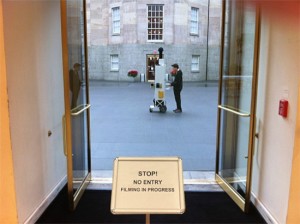The Portrait Gallery and American Art Get the Google Art Project Treatment
As part of the Google Art Project, you can now virtually wander the halls of the museums and see remarkably detailed reproductions of hundreds of works
/https://tf-cmsv2-smithsonianmag-media.s3.amazonaws.com/filer/20120405085007art-project-small.jpg)
Have you ever wanted to wander the halls of the Portrait Gallery or Smithsonian American Art Museum—or see some of their works, such as Andrew Wyeth’s ‘Dodges Ridge,’ in exquisite detail—but can’t make it to DC at the drop of a hat? Now, thanks to the museums’ collaboration with the Google Art Project, you’ll have the opportunity to virtually experience all they have to offer from the comfort of your own home.
On Tuesday, as part of a major expansion of the project, the museums officially became participants, joining 150 other museums and institutions from around the world. As part of the collaboration, Google has created ultra high-resolution scans of 149 of the Art Museum’s pieces and 192 of the Portrait Gallery’s are now freely available for anyone to see online. For some museums, Google has selected a signature image to present at a size over 1 billion pixels (1 gigapixel), allowing viewers to examine the paintings down to remarkably minute details. By comparison, a typical digital camera produces photographs around 10 megapixels in size, or 1000 times smaller than a gigapixel.
Additionally, Google has used its Street View technology to provide remote viewers the chance to virtually tour the halls and galleries of the museums. The company’s special panoramic camera was brought in this past December to capture the interiors, and users can navigate it much as they might tour the streets of the city outside using Street View.

A panoramic camera is used to capture the museum's Kogod Courtyard. Photo courtesy of the American Art Museum
The project was started in February 2011 by Google, and now encompasses more than 32,000 works in total, including paintings, sculptures and drawings. The Smithsonian Cooper-Hewitt National Design Museum in New York also became an official participant today, with more than 1500 pieces represented online. The Smithsonian Institution’s involvement started last year, when more than 200 works from the Freer Gallery were captured and made available as part of the first phase of the project. At the time, Julian Raby, the Freer and Sackler Gallery’s director, commended the level of detail made available in the online reproductions and felt the project would only increase interest in the museum’s offerings.
“The gigapixel allows you to see elements that you would really never ever see, certainly in traditional means of reproduction. You might see the crackle in the oil of a painting, you can sense the brushstroke in the artist’s hand and energy, you can see narrative details you would never see otherwise,” he said. “The traditional thing has been to say that any form of surrogate photograph, video, film will mean that people won’t come to the museums; actually, the experience is quite the opposite. In this particular case, I think it will create a sense of fascination that will engage completely new audiences.”
Check out the project to tour museums such as the Metropolitan Museum of Art in New York and the National Gallery in London in addition to the three four Smithsonian museums that have joined on. You can wander the halls, select your favorite pieces, and build your own virtual gallery that brings together works from around the world. Google encourages art students and teachers to use the content as educational material, and plans to continue expanding the project in future years to make as much art as possible available to anyone, anywhere—so long as they have access to a computer.
/https://tf-cmsv2-smithsonianmag-media.s3.amazonaws.com/accounts/headshot/joseph-stromberg-240.jpg)
/https://tf-cmsv2-smithsonianmag-media.s3.amazonaws.com/accounts/headshot/joseph-stromberg-240.jpg)